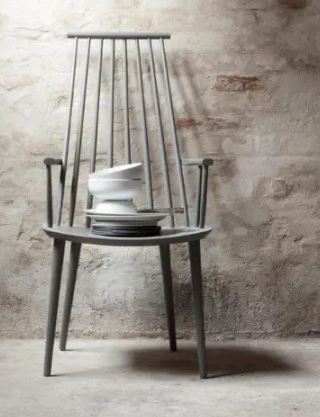Great Mid-Century Designers 101: Poul Volther
Danish designer Poul Volther is best remembered outside of Denmark for his Corona chair, a singular design that is still being produced today. But, as we will see here, his design legacy consists of much more. Volther created a wide range of furniture for the home and also became a teacher, sharing his knowledge and skill with the next generation of Danish designers.
Poul Volther: Beyond the Corona
Poul Volther was born in Denmark 1923. He worked as a joiner for a time then enrolled at the School of Arts and Crafts in Copenhagen, where he studied cabinet-making and architecture. After graduating in 1949, he established his own design and architecture firm. That same year, design legend Hans Wegner introduced Volther to the FDB, a Danish cooperative for consumer goods producers. At the FDB Volther worked under Borge Møgensen. He took over as design director after Møgensen’s departure in 1959. During his career, he also taught at the Royal Danish Academy School of Design. (Pamono.ca, Wilhide, p. 117)
Volther shared the design ethos of his contemporaries. Furniture manufacturer Erik Jørgensen, the producer of the Corona chair, describes his approach on the company's website: “With a starting point in functionalism’s motto ‘form follows function’, Volther designed stylistic, functional furniture where the aesthetic was often paramount.”
One example of form following function is a chair he created while working with FDB. The J110 lounge chair is simple, yet striking in design, but also intended to be a functional, comfortable seat:
Poul Volther J110 Chair. Image from Danish Design Store.
The J110 has been described as “a Nordic and democratic version of a royal seat” with a “cosy” shell and “calm” expression that resembles a “hyper-modern sculpture...as the interplay between the slats and the light performs a delicate shadow dance on the walls and floor.” (ArchiExpo) A recent image from a Copenhagen restaurant shows how the light plays through the slats:
Volther J110 Chair. Image from Apartment Therapy.
Following in sequence, the J111 dining chair had similar sculptural qualities:
Poul Volther J111 Dining Chair. Image from Lauritz.com.
The clean, unadorned design of both the J110 and J111 are evidence of Volther’s general philosophy. He was “strongly opposed to superficial trends and fads in design and had a firm commitment to quality.” (Wilhide, p. 117) The result is timeless designs that remain popular decades later. Indeed, reproductions of both the J110 and J111 are being made today.
His aversion to trendiness did not mean he was afraid to try new things. Volther was keen to experiment with new materials and approaches to design. His first attempt at working with foam resulted in the Pyramid Chair. Created in 1953, it was inspired by time-lapse photos of solar eclipses:
Poul Volther Pyramid Chair. Image from ArtNet.
The Pyramid Chair was not a commercial success, but it did inspire Volther’s most famous design: the Corona chair. Breaking from the Danish tradition of working with hardwood, Volther designed the Corona with a metal frame. (Wilhide) Like the Pyramid, the Corona consisted of a set of elliptical cushions separated by open spaces. (Iconic Interiors claims the spaces in the Pyramid chair were not just aesthetic; they helped economize on materials in the postwar period.)
Volther designed the chair in 1961 and, in 1962, partnered with manufacturer Erik Jørgensen to produce it. The original Corona had a chromed steel frame and tomato red leather upholstery, like this one:
Poul Volther Corona Chair. Image from Lauritz.
The Corona is iconic. Yet Volther’s other designs are also noteworthy. He was a designer completely in sync with others of his time, combining “functional aesthetics” with “rational design thinking.” (Pamono.ca)
Volther’s rational thinking is seen in the flexibility of his designs. The notion of maximizing space was an important part of Scandinavian design; assigning more than one purpose to a given piece ensured smart use of space. His Model C35/J62 acts as both dining table and desk. The modular drawer unit can be moved from side to side or removed altogether and the table itself extends in length for times when more space is needed:
Poul Volther Desk/Dining Table. Images from 1stdibs.
An elegant round coffee table folds in half easily to reduce its size:
Poul Volther Coffee Table. Images from 1stdibs.
Daybeds were popular in the mid-century era. Volther’s model 981 teak version, also called the Diva, featured brackets on the side that easily lifted and slid back to convert the sofa into a bed:
Poul Volther “Diva” Daybed. Images from Pamona.ca.
Volther shared the minimalist, sleek design aesthetic common to other Danish designers, but added his own unique flair. A small teak cabinet he designed features legs in the shape of a mathematical compass that resemble stilts, adding visual interest while also providing enough height to make the cabinet easily accessible. Rounded edges on the body of the cabinet create contrast:
Poul Volther Small Cabinet. Image from Pamona.ca.
Unlike the curvy Corona, Volther’s teak rocking chair features sharp angles, yet it still suits the human body perfectly. Like the Corona, this chair has a spare, open design that provides a similar degree of “sculptural gravity.”
Poul Volther Rocking Chair. Image from 1stdibs.
Volther’s dining chairs use pronounced angles and curves to create comfortable backrests:
Poul Volther Oak J60 Dining Chair. Image from Pamono.ca.

Poul Volther African Teak Dining Chairs. From VHB’s Collection. (Now Sold)

Poul Volther Teak Dining Chairs. From VHB’s Collection. (Now Sold)
And his “Mama Bear” combines all of the various aesthetic elements he favoured: body-hugging curves; high, tapered legs; and angled backrest and armrests:
Poul Volther “Mama Bear” Upholstered Armchair. Images from 1stdibs.
Poul Volther was an accomplished and prolific furniture designer whose works go well beyond the Corona chair. As Erik Jørgensen concludes in its profile of the designer: “With his unerring sense of detail, love for materials and great craftsmanship, Volther has left his mark on Danish and international design history.”






















Leave a comment